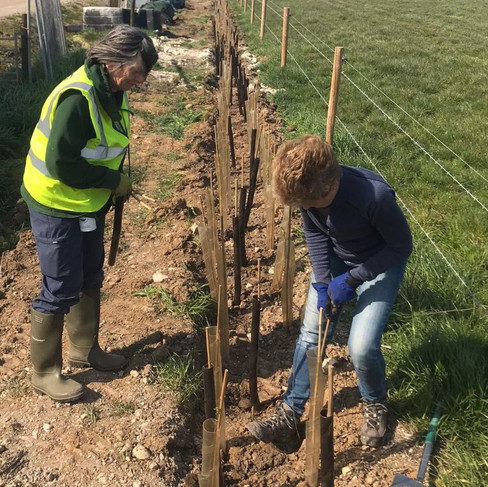Hedge Clipping 18
- Jane Reeve

- Nov 15, 2024
- 3 min read
Updated: Jan 13
Southern Water Biodiversity Grant funded - Hedging Our Future Project
Planting the right tree species in the right places.
There has been a big move to plant trees across the country over the last few years to counteract decades of loss. The locations of this planting must be carefully chosen as sacrificing other important habitats must be considered. Carbon storage is often a driver for tree planting, totally separate to creating a place for nature. However, wildflower meadows, peat bogs and that top 6 inches of soil hold more carbon that newly planted trees and even the actions of digging large holes in the ground and disrupting the soil can release carbon.
There is also the choice of trees to be considered. Ideally use native trees as they would offer the most wildlife value having evolved over millions of years with other species to provide food and shelter. Then geology, soil type, altitude, rainfall, temperature, wind and exposure must also be considered. Then there is where the tree is to be planted; standalone, part of a hedge, woodland copse, shady understory or full sun. How big is the tree going to get and how is it to be managed? More questions to answer which will help with tree species choice.
If a small tree is wanted, that won't grow too large, an Elder, Guelder Rose or Spindle tree could be a good choice as they do not get huge and have good fruit in Autumn. Larger trees like oaks, field maples and beech must have their long term management planned as they will grow into a large canopy and root system. These trees are glorious when allowed to spread fully but will need a large area to do so.
November is the month when the leaves start to come off the trees and the landscape can start to look lifeless. The trees are going into a dormant phase, hunkering down when light levels are low and preparing themselves for the period of springtime renewal. This can be a good time to look for birds as they are no longer hidden by the tree canopy and more visible. Old nests that were hidden deep in the branches of hedges and trees can now be seen.
Bats, hidden deep in rotten out holes and crevices in tree trunks, are hibernating for the cold winter months. Dormice travel down to the base of trees and burrow deep into the moist leaf litter and create nest balls to overwinter inside. Hedgehogs are also looking for a good place to sleep through the winter months in a deep dry bed of leaves.
Trees are vital every season for so many species and that includes the winter months.
This is the month to start planting trees as they are in a dormant state. We will be carrying out this work in the Mundham parish from mid November and plan to plant 5,000 trees to create 1 kilometre of hedgerows. We will need lots of help with this important task which helps to provide environmental resilience in the face of climate change.
Anyone can plant a tree as it does not involve lots of digging. Putting a bamboo cane in the ground or handing out the trees all helps us with this job. You can help to plant a tree to celebrate a life and to create a legacy.
















Comments